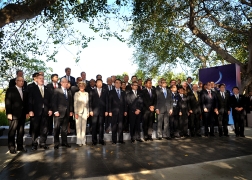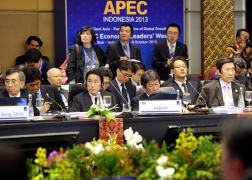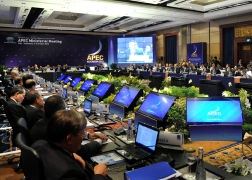Asia-Pacific Economic Cooperation (APEC)
2013 APEC Ministerial Meeting (Overview)
October 5, 2013



On October 4 and 5, the APEC (Asia-Pacific Economic Cooperation) Ministerial Meeting was held in Bali, Indonesia (chaired by Dr. Marty Natalegawa, Minister of Foreign Affairs of the Republic of Indonesia, and Mr. Gita Wirjawan, Minister of Trade of Indonesia). Foreign Ministers and Ministers Responsible for Trade from 21 countries and regions attended the meeting (Mr. Fumio Kishida, Minister for Foreign Affairs, and Mr. Toshimitsu Motegi, Minister of Economy, Trade and Industry, attended the meeting from Japan).
Under the theme of APEC Indonesia 2013, “Resilient Asia-Pacific, Engine of Global Growth”, Ministers exchanged views on a wide range of issues such as trade and investment liberalization and facilitation, promotion of regional economic partnership, achievement of sustainable growth with equity, and promotion of connectivity in the region. As a result of the meeting, a “Joint Ministerial Statement” was released. An overview of the discussion is as follows:
1. Current Situation and Challenges in the region, APEC and the Regional Economic Architecture
(1) APEC members introduced varieties of approaches for the economic growth in the Asia-Pacific region. The participants confirmed that peace and stability of the region is important for regional economic growth.
(2) Ministers reviewed on current economic architecture in the Asia-Pacific region. They underscored the importance of creating a synergy and complementarity between APEC and other international and regional fora. At the same time, the participants agreed that they would discuss this issue towards 2014.
(3) Japan stated the following:
- Implementation of Japan’s new economic policy such as the Growth Strategy contributes to the growth of the APEC region and, as a result, to the growth of the global economy.
- In order for the APEC region to realize a stable business environment and achieve further economic growth, establishment of the “Rule of Law” including “Freedom of Navigation” in the entire region is important.
- The significance of APEC includes: 1) Improvement of transparency of the regional trade agreements in the region; 2) innovative approach enabled by the non-binding spirit of APEC; and 3) appropriate response to the business needs.
2. WTO Doha Round Negotiations, 9th WTO Ministerial Conference, Bogor Goals
(1) Each economy expressed its political will for the success of the 9th WTO Ministerial Conference (MC9). Many economies stated that APEC should send a strong message for the expansion of the WTO Information Technology Agreement (ITA).
(2) Concerning the attainment of the Bogor Goals, while progress toward 2020 was welcomed, many economies pointed out the necessity of further improvement of efficiency of supply chain and capacity building including support for human resource development.
(3) Japan stated the following:
- For the success of the MC9, negotiations such as trade facilitation should be accelerated, ITA expansion negotiation should be concluded before the MC9 and the deadline of the standstill commitment should be extended by one year, through the end of 2016.
- Japan emphasizes the role of APEC as an incubator of the Free Trade Area of the Asia-Pacific (FTAAP). Frameworks toward regional economic integration, such as TPP or RCEP, are being negotiated and Japan appreciated the solid progress of agreements in Yokohama in 2010, “Pathway to FTAAP.” Japan is participating in all of these region-wide frameworks. Japan will take the lead by bridging these regional initiatives.
3. Sustainable Growth with Equity, Connectivity in the Region
(1) Participants explained their policies for realizing sustainable growth with equity in the fields of support for Small and Medium-Sized Enterprises (SMEs), women’s economic empowerment, and renewable energy.
In terms of the promotion of connectivity in the APEC region, the participants agreed to promote infrastructure development, improvement of supply chain, and cross-border education cooperation and others.
(2) Regarding sustainable growth with equity, Japan introduced the “SME Overseas Business Support Platforms” to strengthen partnership between Japanese and APEC region’s local SMEs, as well as Japan’s new growth strategy to promote the empowerment of women. Japan also introduced the “Joint Crediting Mechanism” led by Japan as an approach to encourage investment in the field of environment.
(3) With regard to the promotion of connectivity in the APEC region, Japan pointed out that life cycle cost analysis is important in infrastructure development. Japan at the same time expressed its intention to make contributions by utilizing experience and knowledge that Japan has accumulated, in the fields including export of infrastructure, disaster management, youth exchanges, tourism and business exchanges by easing of visa requirements, and promotion of women’s participation in society.

